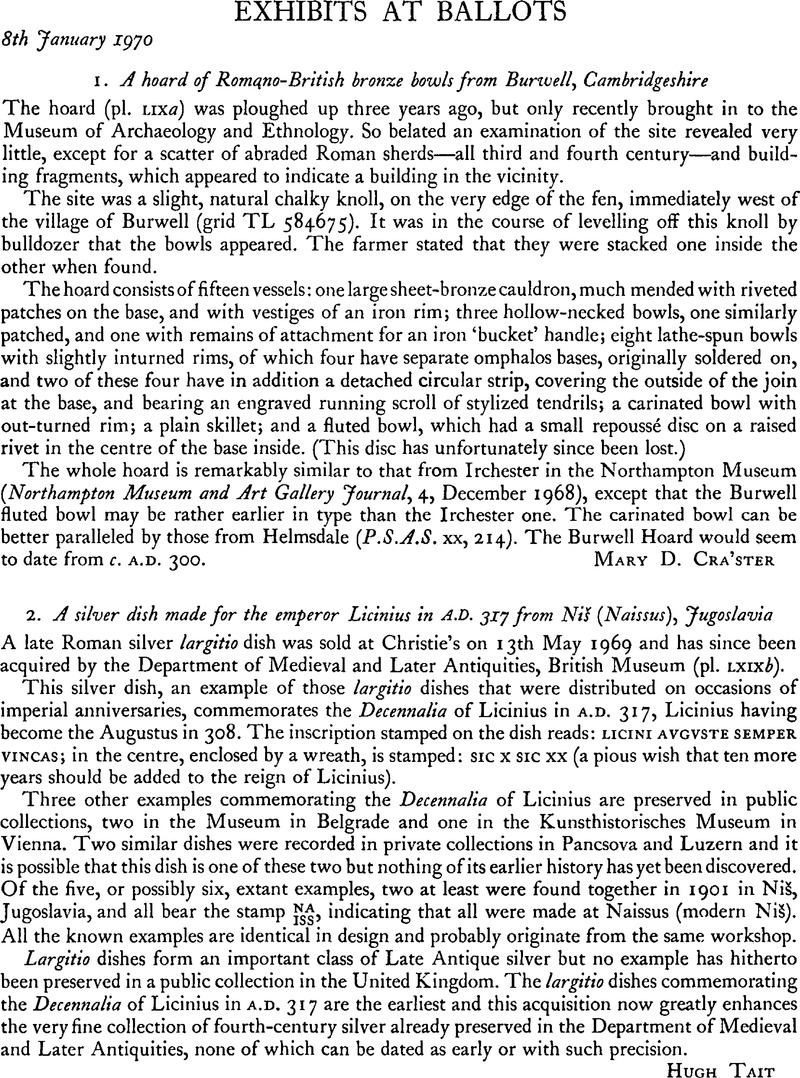No CrossRef data available.
Article contents
Exhibits at Ballots
Published online by Cambridge University Press: 29 November 2011
Abstract

- Type
- Exhibits at Ballots
- Information
- Copyright
- Copyright © The Society of Antiquaries of London 1970
References
page 347 note 1 Purchased from a private collector, these tiles had no earlier recorded history and were first seen and recognized by Mr. Laurence Keen.
page 347 note 2 The piece is number 2502 in the collection of the Egyptian Museum, Charlottenburg, West Berlin (formerly in the Minutoli Collection before 1875). It has been kindly lent to the exhibitor by the Director, Professor Dr. Jurgen Settgast, for it to be examined by micro-spectrographic analysis in conjunction with three other bronze shawabti figures. Bibliography: Roeder, G., Ägyptische Bronzejiguren (Berlin 1956), p. 294Google Scholar.
page 347 note 3 The only other parallels among royal shawabtis for this insertion of the two additional elements in the head-dress are to be found amongst the shawabtis provided for the burial of the earlier, XVIIIth Dynasty Pharaoh Tut-ankh-amun (died 1352 b.c.). Those seven concerned are all of wood, save for the bronze additions, and are numbers no, 326A, 330 a, b, e, f, and 458 in Howard Carter's unpublished notes housed in the Griffith Institute, Oxford. Of the seven examples cited only two wear the insignia in conjunction with the nemes head dress as does Ramesses II; they are numbers 110 and 458. The other examples with this insignia wear it variously with a round wig; the Red Crown (Deshret); the White Crown (Hedjet); and the Double Crown (Sekhemty) combining both the latter forms of crown.
page 328 note 1 Private collection.
page 328 note 2 Montet, P., Les Constructions et le Tombeau de Psousennès à Tanis (Paris 1951)Google Scholar.
page 328 note 3 Of the examples now shown in the Cairo Museum a number were bought back in several lots, or were given.
page 328 note 4 Society of Antiquaries Minute Books, xix, 407.
page 328 note 5 Dissertations on Celts', Bibliotheca Topographica Britannica, i, 1785, 7 and see also Soc. Ant. MS. 723, 40.
page 349 note 1 Chaffers, William, ed. Barber, Fairless, A Series of Photographs of Objects of Archaeological interest from the National Exhibition of Works of Art at Leeds, 1868, London, 1869Google Scholar, pi. xi and text. A footnote refers to the ansate panel of the now well-known dedication tablet to Serapis at York in relation to the form of the axe.
page 349 note 2 Körte, Gustav, ‘Gottinger Bronzen’, Arch. Inst. Univ. Göttingen, ii, 1916, 53Google Scholar and pi. xvii. Johansen, K. F., ‘Sacena. Zur Geschichte der römischen Opfergeräte’, Acta Archaeologica, iii, 1932Google Scholar, 152, fig. 25.
page 349 note 3 Wiesler, F., ‘Arch. Anzeiger’, Jahrb. des Arch. Insts. v, 1890, iGoogle Scholar, 13, no. 9, hence Körte, 52 and pi. xvii.
page 350 note 1 One is illustrated in J. L. N. Myres, Anglo-Saxon Pottery and the Settlement of England, 1969, pl. 8b




